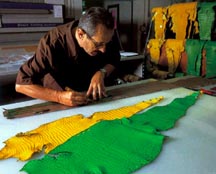How Bourgeois
Julie Frederickson, a.k.a. Almost Girl, has done a great job rounding up blog posts that provide a window into the attitudes of the young and fashionable. As someone who thinks Carrie Bradshaw had great attitude but hideous clothes (and don't get me started on the scary, misanthropic Jim Kuntsler), I feel a little out of place on her Black Friday blogroll. I'm more comfortable around computer geeks, not to mention economists, than fashionistas. But I do like beautiful, tactile clothes and the markets that provide them.
Those markets don't always behave the way fashionistas would like, leading to some contradictory blogging on Julie's part. In this post, she bemoans the latest trend in luxury markets, quoting a WWD article:
In a buoyant luxury market, ultraexpensive items--from $6,000 Azzedine Alaïa shearling jackets to $21,000 Bottega Veneta handbags--have become a surprise hit, selling briskly to a superrich clientele in search of the exceptional.
Julie has understandable sticker shock. What a waste of money! "I'll tell you what, you want to get something exceptional? Fund me for an entire year! I can easily live off of $21,000 (I live off of about $1,000 a month now and quite comfortably I might add, not including the cost of my college tuition). For the cost of one of your hand bags you could send me to New York City so that I could have the resources to pursue my dream in the glossies....So if anyone out there is reading this blog I would like a patron please! I promise to provide compelling articles, do valuable research, and add a needed dose of intellectualism to the fashion scene! Will you really miss the handbag?"
As an equally bourgeois person who considers my $400 purse (bought when I was 45 and had been self-supporting for more than two decades) a huge splurge, I sympathize. But this attitude directly contradicts an earlier posting on how the trendy but cheaply constructed "fast fashion" (analogous to fast food) at stores like H&M has eroded the public's appreciation of craftsmanship and fine design. Julie and other fashion bloggers also worry that big chains, with their mass merchandising, make it hard for young designers to find a market.
The "fast fashion" post mixes a lot of different issues, but the economic bottom line is that people should buy more expensive clothes, at more expensive stores, and keep them longer. "Let's appreciate everything that goes into our clothing, have less of it but make it better," she writes.
Here we have a classically bourgeois attitude, with an elitist twist. Cheap is bad, and so is expensive. The right price is the one I'm willing to pay. The right priorities are mine.


But those Bottega Veneta bags are expensive for a reason. They not only use luxurious, expensive materials, but require meticulous, time-consuming craftsmanship. Only a few people in Italy have the necessary skills. And since the "production runs" are quite small, distribution and logistic costs are quite high per bag. I'm not saying that everyone should lust after a $21,000 purse (my car didn't cost that much, and I bought it new), only that rare design and craftsmanship have a cost. You can't have Bottega Veneta quality at H&M prices. The ultra-high end market is preserving artisanal skills.
 And luxury companies know that in a world of fast fashion, they need to sell the intrinsic qualities of their merchandise. "We are back to luxury as an indulgence, not a show," said Bottega Veneta CEO Patrizio di Marco at the World Luxury Congress, a conference last month in Paris. (I was one of the speakers, the only one who talked not about luxury per se but about the increasingly aesthetic economy in which luxury goods compete.)
And luxury companies know that in a world of fast fashion, they need to sell the intrinsic qualities of their merchandise. "We are back to luxury as an indulgence, not a show," said Bottega Veneta CEO Patrizio di Marco at the World Luxury Congress, a conference last month in Paris. (I was one of the speakers, the only one who talked not about luxury per se but about the increasingly aesthetic economy in which luxury goods compete.)
The great thing about fashion markets today is how diverse they are, even outside of major metro areas. Many different styles coexist and there isn't a simple, price-based status hierarchy. You can buy trendy but disposable clothes--"fast fashion"--or classic, enduring pieces. Basic jeans, sweaters, and T-shirts cost about the same, in nominal dollars, as they did when I was a teenager in the late 1970s, and their materials and construction are generally much better. Those cheap clothes are also helping a billion Chinese climb out of abject poverty.
The bad thing about fashion markets today is how many empire-waist tops and dresses they sell. I don't care how cute, young, and skinny you are. Those things make you look pregnant.